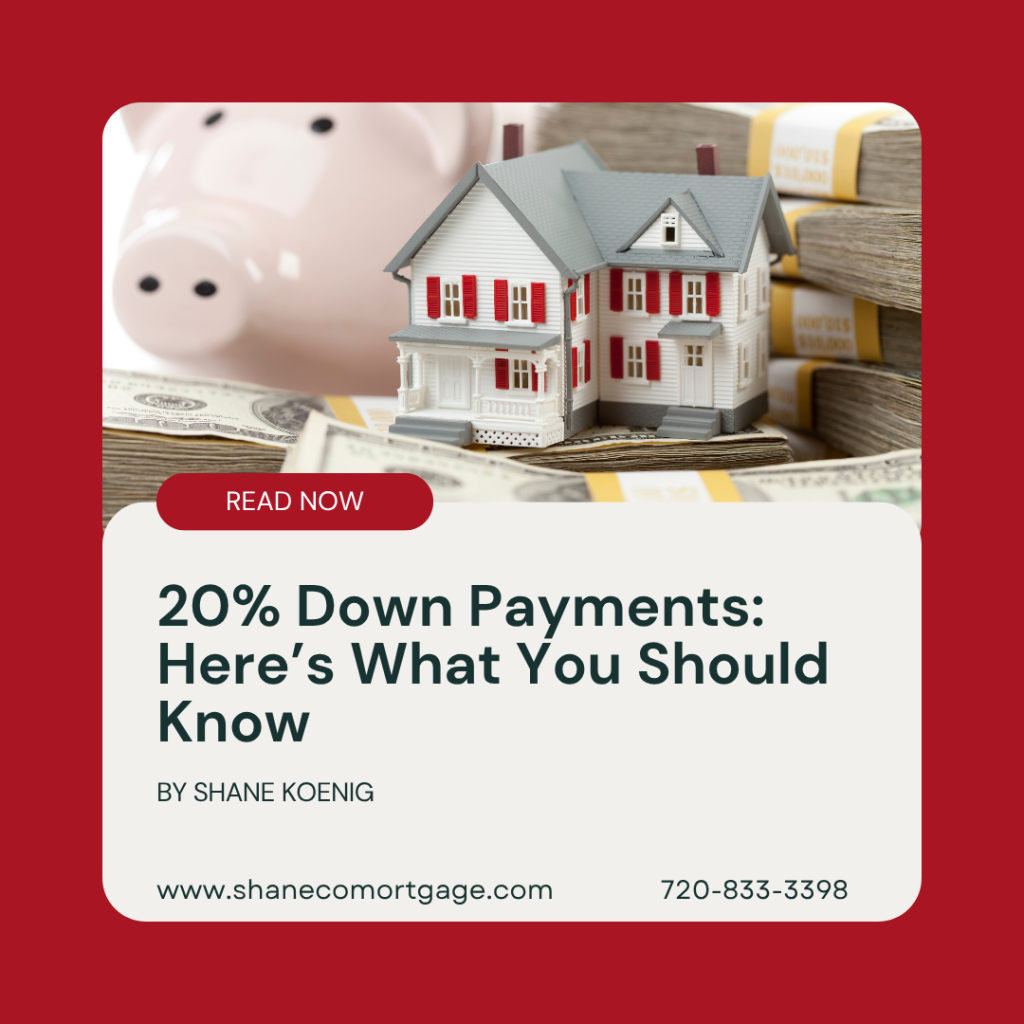If you’ve bought a house or are in the process of buying your first home, you’ve more than likely asked yourself this question: Do I really need a 20% down payment? You know you need to save, but how much? You’ve heard it from your parents that 20% is the standard down payment on a home, but is that still true? Even a quick Google search gives mixed answers — some say you can put down as little as 3%, while others warn you’ll face higher monthly payments without the full 20%.
So, what’s the truth?
I’m Shane Koenig — licensed mortgage loan officer in Colorado, and I’ve helped families across the state answer their questions, find clarity, and get the keys to their dream home. I’m committed to providing the best mortgage education and resources to help families just like yours confidently navigate the confusion of down payments. When it comes to buying a home, it is a common misconception that you need to put a 20% down payment for a house. In reality, there are multiple different loan options with lower down payment options so you can make your dream house a home.
In this blog, we’re breaking down where the 20% rule came from, what it means for today’s buyers, and how much you actually need to put down to get the keys to your next home.

What is a Mortgage?
Simply: a mortgage is a loan you take out from a lender to purchase a home.
Each lender and mortgage program offers different terms for repaying the loan. Most home buyers can choose between a fixed interest rate, which remains constant throughout the loan term, or an adjustable interest rate, which fluctuates over time.
While you’re making payments, the lender holds a legal claim on your home, meaning they have the right to take possession if the loan isn’t repaid. Choosing the right mortgage is a crucial step in the home buying process, and it’s essential to select one that aligns with your financial goals and lifestyle.
What is a Down Payment?
A down payment is the upfront cash you pay toward the purchase of a home. It’s calculated as a percentage of the total home price. For example, if you’re buying a $400,000 home and you put down 20%, that’s $80,000 upfront — and your mortgage covers the remaining $320,000.
The size of your down payment affects everything from your loan options to your monthly payment amount. In general, a larger down payment means you’ll borrow less, pay less interest over time, and potentially avoid additional costs like private mortgage insurance (PMI). But contrary to popular belief, putting down less than 20% doesn’t mean you can’t buy a home or that it’s a bad idea.
Next, let’s look at where the 20% down payment rule comes from and why it’s stuck around for so long — even when it’s not always required.

Where Did the 20% Down Payment “Rule“ Come From?
The idea of a 20% down payment as the “standard” is a modern convention, but its roots trace back to major changes in the mortgage system during the Great Depression.
Before 1930, home loans looked very different from today’s. Most mortgages were short-term (3 to 5 years), non-amortizing (meaning you paid only interest during the loan), and required large down payments — often 30% to 50%. At the end of the term, borrowers had to pay off the entire balance or refinance, which became nearly impossible during the market collapse.
In response to the housing crisis, the federal government created the Federal Housing Administration (FHA) in 1934. The FHA didn’t invent the 20% down payment. In fact, it lowered the barrier to entry for many by insuring mortgages with down payments as low as 10% (and eventually lower). This shift helped make long-term, fixed-rate, fully amortizing loans the new norm.
So where did the 20% rule come from? It became a widely accepted benchmark for conventional (non-FHA) loans because it’s the threshold at which you can avoid PMI — a fee most lenders require if your down payment is below 20%. Over time, that benchmark turned into a myth that you must put 20% down to buy a home, even though plenty of buyers qualify with far less.

So, What Are Most Buyers Putting Down?
If buyers don’t need 20% to put down on a home, what are they putting down? The National Association of Realtors has tracked exactly this. They know that in 2024, the median down payment was 18% — 9% for first-time buyers. Repeat home buyers put down an average of 23%.
So, what does this tell us?
It shows that while 20% is often seen as ideal, it’s not the reality for most buyers — especially first-time buyers. In fact, the majority are putting down significantly less and still successfully closing on homes. Today’s mortgage landscape offers flexibility, and many loan programs are designed to make homeownership more accessible without needing to hit that 20% mark.
For first-time buyers especially, that 9% median down payment proves that you don’t have to wait until you’ve saved tens of thousands of dollars to get started. With the right loan, a solid plan, and the right lender by your side, you can take the next step toward homeownership sooner than you think.
Next, let’s break down the loan programs that make this possible — and what you need to know about PMI.

The Different Types of Home Loans
Not all mortgages are created equal. Whether you’re buying your first home or your third, choosing the right loan can impact your down payment, interest rate, and monthly payment. Let’s take a look at the most common home loan options and who they’re best suited for.
Conventional Loans
Conventional loans are offered by private lenders and are not backed by the government. These loans typically require a down payment between 3% and 5%. To qualify, most buyers need a credit score of at least 620 and a stable financial history. Conventional loans are a strong option for buyers with solid credit who want more flexibility in terms and property types.
FHA Loans
FHA loans are government-backed mortgages insured by the Federal Housing Administration. They’re designed to help buyers with lower credit scores or smaller down payments — often as low as 3.5%. If your credit score is 580 or higher, you can qualify for this lower down payment. However, if your credit score falls between 500 and 579, you’ll need a minimum down payment of 10%. Because FHA loans allow credit scores as low as 500 with these conditions, they offer more flexible qualification standards, making them a popular choice for first-time homebuyers or those with less-than-perfect credit.
VA Loans
VA loans are mortgage programs backed by the U.S. Department of Veterans Affairs, designed exclusively for eligible veterans, active-duty service members, and certain members of the National Guard and Reserves. One of their biggest benefits? No down payment is required in most cases, making homeownership more accessible. VA loans also typically offer competitive interest rates and don’t require PMI, saving borrowers money both upfront and over time.
USDA Loans
USDA loans are backed by the U.S. Department of Agriculture and designed to help low- to moderate-income buyers purchase homes in eligible rural and suburban areas. These loans often require no down payment, making them an affordable option for qualified buyers. USDA loans also offer competitive interest rates and reduced mortgage insurance costs, but they come with geographic and income eligibility requirements.

What Is Private Mortgage Insurance?
Private mortgage insurance is a type of insurance that protects lenders if a borrower defaults on their mortgage. Most lenders require PMI when a homebuyer puts down less than 20% on a conventional loan.
PMI doesn’t protect you — it protects the lender — but you pay for it as part of your monthly mortgage payment. The cost varies depending on factors like your down payment size, credit score, and loan amount.
One good thing? Once you’ve built up enough equity in your home (usually when your loan balance drops below 80% of the home’s value), you can typically request to cancel PMI to lower your monthly payment.
Are There Down Payment Assistance Programs in Colorado?
Yes! Colorado offers a variety of down payment assistance programs designed to help first-time and eligible buyers overcome the hurdle of saving for a down payment. These programs are available statewide and through local municipalities, providing financial support in the form of grants or deferred loans.
Colorado Housing and Finance Authority (CHFA)
CHFA is a key resource for homebuyers in Colorado, offering several programs for home buyers:
- FirstStep and FirstStep Plus: These programs provide 30-year fixed-rate FHA loans with options for down payment assistance. FirstStep Plus offers up to 4% of the first mortgage amount as a second mortgage, which is deferred until the home is sold, refinanced, or no longer the primary residence.
- Down Payment Assistance Grant: This grant provides up to 3% of the first mortgage amount, capped at $25,000, to assist with down payment and closing costs. This grant does not require repayment.
Colorado Housing Assistance Corporation (CHAC)
CHAC offers zero-interest second mortgage loans up to $25,000 for down payment and closing costs. These loans are available to first-time homebuyers meeting income requirements and must be repaid.
Chenoa Fund
The Chenoa Fund provides down payment assistance up to 5% of the purchase price. It offers both repayable and forgivable loan options, with no income limits or first-time homebuyer requirements.

What are the Benefits of a Smaller House Down Payment?
When applying for different mortgages that allow you to put down less than 20% on a down payment for a house, you set yourself up to buy a home as soon as possible. This could be due to competition over a specific house, desperate circumstances, or an attempt to capitalize on rising property values.
Overall, there are many benefits to capitalize on. For example, making a lower down payment allows for a higher budget for property renovations, moving expenses, or other short-term expenses. For first-time homebuyers, buying a home sooner not only increases the value of the house but also allows you to start building equity. For many buyers, these mortgages are not a shortcut, but a wise strategic financial decision.
But remember! Putting less than 20% down often means you’ll pay for private mortgage insurance (PMI), which adds to your monthly costs until you build enough equity. It’s important to weigh the benefits of buying sooner against the potential increase in your monthly payment.

Things to Consider as You Buy a Home:
- What is my budget?
- Is my income stable?
- Can I take out a long-term loan?
- What is my plan of action?
- What is my emergency plan?
- Why am I choosing a specific home loan?
- Do I qualify for loan programs or assistance?
- What are my local market conditions?
- Would a lower down payment give me more financial breathing room, or cost more in the long run?
- Is my priority building equity, owning outright, or keeping debt low?
- What are my long-term financial goals?
Have Questions About Homeownership?
If you still have questions about down payments, mortgage options, or the home buying process in general, you’re not alone. Navigating the world of homeownership can feel overwhelming, especially with so much conflicting information out there. Taking the time to get clear, trustworthy guidance now will save you time, money, and stress down the road.
Whether you’re curious about how much you really need to save, want to understand the pros and cons of different loan programs, or just want to chat about your specific situation, reach out to me at Shane CO Mortgage. Remember, every buyer’s path is unique, and having the right support can make all the difference in turning your dream of homeownership into reality.
Don’t wait to get the answers you need — your future home might be closer than you think.
